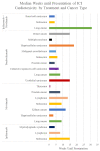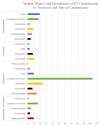Cardiac Toxicity Associated with Immune Checkpoint Inhibitors: A Systematic Review
- PMID: 34680365
- PMCID: PMC8534225
- DOI: 10.3390/cancers13205218
Cardiac Toxicity Associated with Immune Checkpoint Inhibitors: A Systematic Review
Abstract
Immune checkpoint inhibitors are immune stimulatory drugs used to treat many types of cancer. These drugs are antibodies against inhibitory proteins, such as CTLA-4 and PD-1/PD-L1, that are expressed on immune cells. When bound, they allow for increased stimulation of T cells to fight tumor cells. However, immune checkpoint inhibitors have several immune-related adverse effects. Many cases have come to light recently of cardiotoxicity as a result of treatment with these drugs. Cardiotoxicity from immune checkpoint inhibitors is unique due to its rarity and high mortality rate. Patients with this toxicity may present with myocarditis, pericarditis, Takotsubo cardiomyopathy, conduction disorders, and others within just a few weeks of starting immune checkpoint inhibitors. We present here a review of the current research on immune checkpoint inhibitors, their associated cardiotoxicities, the timing of presentation of these conditions, lab tests and histology for each condition, and finally the treatment of patients with cardiotoxicity. We observe a positive skew in the onset of presentation, which is significant for the treating physician.
Keywords: cardiac toxicity; cardiotoxicity; cytotoxic T-lymphocyte-associated protein 4 (CTLA-4) inhibitors; immune checkpoint inhibitors (ICIs); immune-related adverse events (IRAE); programmed cell death protein 1 (PD-1); programmed death-ligand 1 (PD-L1).
Conflict of interest statement
The authors declare no conflict of interest.
Figures


References
-
- Varricchi G., Galdiero M.R., Marone G., Criscuolo G., Triassi M., Bonaduce D., Marone G., Tocchetti C.G. Cardiotoxicity of immune checkpoint inhibitors. [(accessed on 5 July 2021)];ESMO Open. 2017 2:e000247. Available online: https://pubmed.ncbi.nlm.nih.gov/29104763/ - PMC - PubMed
-
- Rowshanravan B., Halliday N., Sansom D.M. CTLA-4: A moving target in immunotherapy. [(accessed on 30 June 2021)];Blood Am. Soc. Hematol. 2018 131:58–67. doi: 10.1182/blood-2017-06-741033. Available online: http://ashpublications.org/blood/article-pdf/131/1/58/1367947/blood74103.... - DOI - PMC - PubMed
-
- Tarrio M.L., Grabie N., Bu D.-X., Sharpe A.H., Lichtman A.H. PD-1 Protects against Inflammation and Myocyte Damage in T Cell-Mediated Myocarditis. [(accessed on 27 June 2021)];J. Immunol. 2012 188:4876–4884. Available online: https://pubmed.ncbi.nlm.nih.gov/22491251/ - PMC - PubMed
Publication types
LinkOut - more resources
Full Text Sources
Research Materials
Miscellaneous

